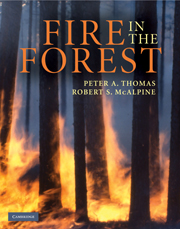Book contents
- Frontmatter
- Contents
- Preface
- List of contributors
- 1 In the beginning
- 2 Historical review
- 3 How a fire burns
- 4 Fire in the wild landscape
- 5 Fire ecology
- 6 The benefits of fire and its use as a landscape tool
- 7 Fire suppression
- 8 Wildland fire and its management – a look towards the future
- Further reading
- References used in the text
- Index
7 - Fire suppression
Published online by Cambridge University Press: 05 August 2012
- Frontmatter
- Contents
- Preface
- List of contributors
- 1 In the beginning
- 2 Historical review
- 3 How a fire burns
- 4 Fire in the wild landscape
- 5 Fire ecology
- 6 The benefits of fire and its use as a landscape tool
- 7 Fire suppression
- 8 Wildland fire and its management – a look towards the future
- Further reading
- References used in the text
- Index
Summary
Prior to the arrival of humans, fires came and went, the forest grew, burnt, and regrew. Fire was a systematic, natural process within many ecosystems. With the arrival of early humans, fire became more prevalent on the landscape (with the new fire starters), and the ecosystem adapted to the changing regime. It is only in the last 100 years or so that humans have found the need to systematically suppress fire and attempt to eliminate its destructive nature – essentially to tame it. Suppression activities began in earnest after World War II when aeroplanes, helicopters, smokejumpers and new firefighting strategies were introduced. Why have we attempted to remove this element of the ecosystem from its natural role? The answer is simple, of course – fire competes with us for natural resources, fire threatens and destroys our property and it can kill. In many parts of our world, the economy is dependent on the renewable resources found in the forest. Our lives and lifestyles also depend on homes, buildings, telecommunication towers and lines, pipelines and a host of other infrastructure elements in and around wildlands (natural or semi-natural forest) at risk of fire. The normal feeling is that fire cannot be allowed to threaten and disrupt our lives and economy. The existence and mission of fire suppression is thus based on the protection of human life, property and the resources upon which economies depend.
- Type
- Chapter
- Information
- Fire in the Forest , pp. 149 - 182Publisher: Cambridge University PressPrint publication year: 2010



